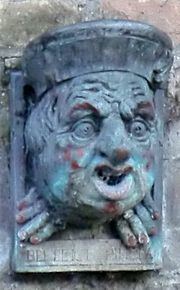Decided 1615 | End date 1615 | |
 | ||
Citation(s) (1615) 1 Ch Rep 1, (1615) 21 ER 485 Similar Walsh v Lonsdale, Milroy v Lord, Westdeutsche Landesbank Girozentr, Paul v Constance, Vandervell v IRC | ||
Earl of Oxford’s case (1615) 21 ER 485 is a foundational case for the common law world, that held equitable principle takes precedence over the common law.
Contents
Facts
A parcel of land at St Botolph's Aldgate in London was sold by Magdalene College, Cambridge, to Queen Elizabeth I, and then to Benedict Spinola, a Genoese merchant. A statute, 13 Eliz c 10, provided that conveyances of estates by the masters, fellows, any college dean to anyone for anything other than a term of 21 years, or three lives, ‘shall be utterly void’. It was thought transfer to the Queen would grant unimpeachable title. Spinola thought this, and so did Edward de Vere, the Earl of Oxford, who bought the land in 1580 and built 130 houses. John Warren leased a house through intermediaries.
Then, Barnabas Gooch, Master of Magdalene College, claimed that he was able to lease the land to John Smith. Warren brought an action of ejection against Smith, but his lease expired before it was heard by court. Warren asked the question to be decided anyway.
Jury
The Jury held that Smith had taken possession unlawfully (ie through the later sale by Gooch on behalf of the College) and so the sale was good. This ultimately meant that Warren was entitled to eject Smith.
King's Bench
Chief Justice Coke held the initial land transfer was void, caught by the statute 13 Eliz c 10. The Queen was ‘the fountain of justice and common right’ and could not be exempted from a statute aimed to maintain the advancement of learning. Therefore, Goche had validly leased the property again to Smith. Warren could not eject Smith.
In the meantime, Edward de Vere had died, and was succeeded by Henry de Vere, who was still a minor. He and another tenant, Thomas Wood, brought the case to the Court of Chancery. Barnabas Gooch and John Smith refused to answer the bill, saying it was void. They refused to appear. The Chancery Court committed them to Fleet Prison for contempt of court.
Chancery
Lord Ellesmere LC, issued a common injunction out of the Court of Chancery prohibiting the enforcement of the common law order, and granting the Earl of Oxford and his tenants quiet enjoyment of the land, in other words meaning that the statute did not void the initial transaction of the land. It stayed all common law suits against the Earl. He began his judgment by referencing the Bible, Deuteronomy 28:30, saying he "that builds a House ought to dwell in it; and he that plants a Vineyard ought to gather the Grapes thereof." He remarked that common law judges themselves ‘play the Chancellors Parts’ in taking the equitable construction of statutes to be law properly speaking. The Chancery, however, was not like a Court of Appeal. Instead, the Chancery had a unique position.
Significance
After Lord Ellesmere's decision, the two courts became locked in a stalemate. The matter was referred to Attorney General Sir Francis Bacon. Lord Ellesmere LC effectively appealed to King James I, who referred the matter to the Attorney General for the Prince of Wales and Francis Bacon, the Attorney General for England and Wales. Both recommended a judgment in Lord Ellesmere's favour, which King James I approved. He issued a declaration saying:
Thus, the King had decreed that if there was a conflict between the common law and equity, equity would prevail. Equity’s primacy in England was later enshrined in the Judicature Acts in 1873 and 1875, which also served to fuse the courts of equity and the common law (although emphatically not the systems themselves) into one unified court system.
